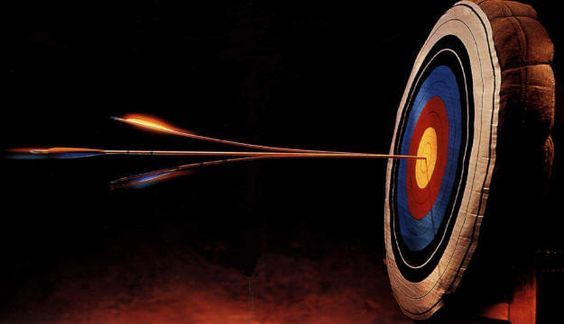Krishna v/s Robin Hood!

Krishna is new to archery. Without any prior practice, he has been put into a match against the champion Robin Hood.
Rules of the game:
-
Each will shoot 3 times and the best two shots will be selected.
-
The minimum radius that can enclose all the shots is selected and the percentage of area of that is left is calculated.
-
Points will be calculated as the percentage of area rounded off to the greatest integer less than it.
Also, Krishna can learn from his mistakes. The chance that his shot will be within a given radius is equal to the the chance that he was able to shoot in the given radius at least once before.
Now, Robin Hood starts the game. What score can Robin Hood score and we can still expect Krishna to win?
Details and assumptions:
-
The board is a circle of radius 1.
-
On his first shot, Krishna is certain to shoot on the board while he is equally likely to shoot anywhere on the board.
The answer is 56.
This section requires Javascript.
You are seeing this because something didn't load right. We suggest you, (a) try
refreshing the page, (b) enabling javascript if it is disabled on your browser and,
finally, (c)
loading the
non-javascript version of this page
. We're sorry about the hassle.
Let the distances of Krishna's three arrows from the centre of the target be the random variables R 1 , R 2 , R 3 . Then R 1 , R 2 have the same distribution, with PDF f ( r ) and CDF F ( r ) given by f ( r ) = 2 r F ( r ) = r 2 0 ≤ r ≤ 1 while R 3 has PDF g ( r ) and CDF G ( r ) given by g ( r ) = 4 r − 4 r 3 G ( r ) = 1 − ( 1 − r 2 ) 2 = 2 r 2 − r 4 0 ≤ r ≤ 1 The distance of the middle of Krishna's arrows from the centre is the random variable M which has PDF (we need to deal with whether the third arrow is the nearest, middle or furthest from the centre) f M ( r ) = = 2 G ( r ) × f ( r ) × ( 1 − F ( r ) ) + 2 F ( r ) × g ( r ) × ( 1 − F ( r ) ) + 2 F ( r ) × f ( r ) × ( 1 − G ( r ) ) 4 r 3 ( 1 − r 2 ) ( 5 − 4 r 2 ) for 0 ≤ r ≤ 1 . Krishna's point score is W = ⌊ 1 0 0 ( 1 − M 2 ) ⌋ and so we need to calculate E [ W ] = ∫ 0 1 ⌊ 1 0 0 ( 1 − r 2 ) ⌋ f M ( r ) d r A simplistic calculation shows that ∫ 0 1 1 0 0 ( 1 − r 2 ) f M ( r ) d r = 3 1 7 0 = 5 6 3 2 This is, of course, greater than E [ W ] , which is in fact equal to j = − 0 ∑ 9 9 j ∫ 1 − 1 0 0 j + 1 1 − 1 0 0 j f M ( r ) d r = 5 0 0 0 0 0 0 2 8 0 8 3 3 3 3 3 = 5 6 . 1 6 6 7 Both of these values lie between 5 6 and 5 7 .
Thus the largest integer score that Robin Hood can obtain, and still have Krishna expect to win, is 5 6 . Of course, with a graphic like the one with the question (and according to the stories about Robin Hood's splitting arrows), Robin would be able to score a perfect, or near perfect, score, so Krishna would need to practise a lot more!